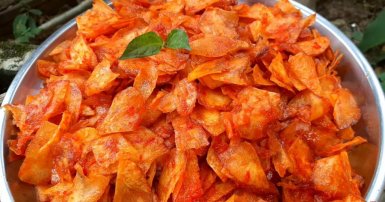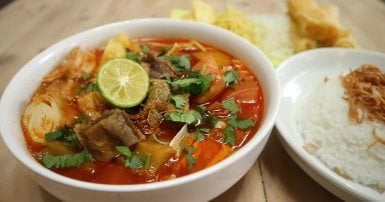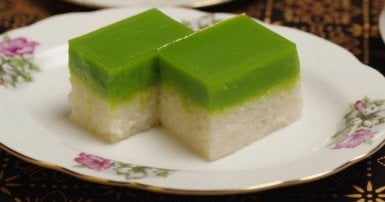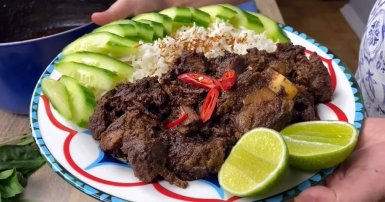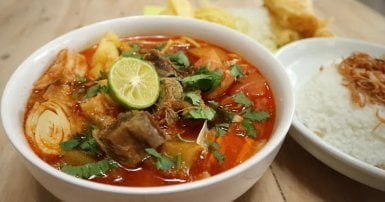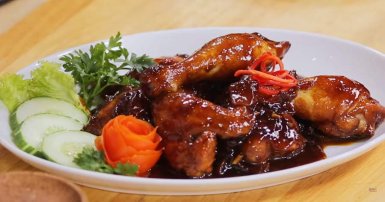Indonesia's vegetarian cuisine is a vibrant tapestry of flavors, drawing inspiration from the archipelago's rich culinary traditions. Bursting with exotic spices, fresh herbs, and diverse tropical ingredients, it offers an array of tantalizing dishes that celebrate the abundance of plant-based fare. From fragrant coconut-infused curries to tangy sambal-tossed tempeh, each bite is a journey through Indonesia's diverse landscapes and cultural influences.
Gado-Gado
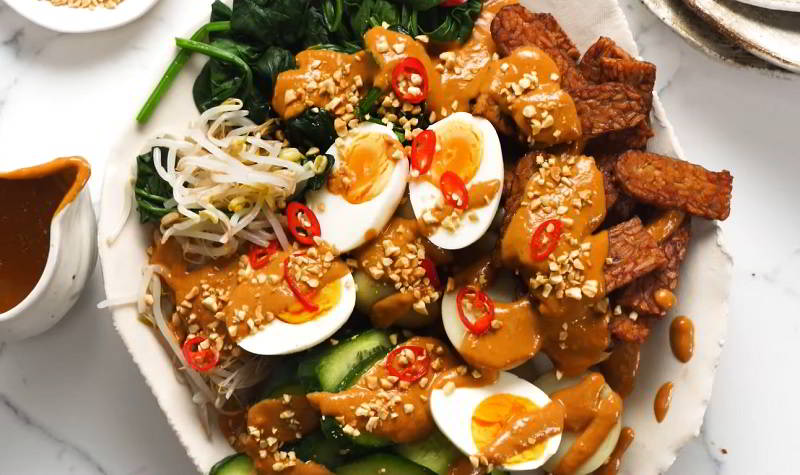
Gado-gado, a beloved Indonesian dish, is known for its refreshing and flavorful mix of vegetables, tofu, and peanut sauce. Its name, which translates to "mix-mix" in English, perfectly captures the diverse range of ingredients used. The dish starts with blanched or steamed vegetables like cabbage, bean sprouts, green beans, and spinach, providing a crunchy and nutritious base. Alongside these vegetables, gado-gado often includes boiled potatoes, tofu, and hard-boiled eggs, adding various textures and flavors. The star of the dish is the rich and creamy peanut sauce, made from ground peanuts, garlic, chili, tamarind, and palm sugar. This sauce is generously poured over the vegetables and other components, resulting in a harmonious blend of sweet, savory, and spicy flavors.
Papeda
-1709813013.jpg)
Papeda is a traditional dish originating from Eastern Indonesia, commonly consumed by the indigenous people. It is prepared by extracting starch from the sago palm tree's trunk, which involves cutting the trunk, scraping out the soft inner parts (pith), and processing it into flour. This flour is then mixed with water, strained to separate the starch, and cooked until it thickens into a gluey consistency, forming papeda.
Klepon
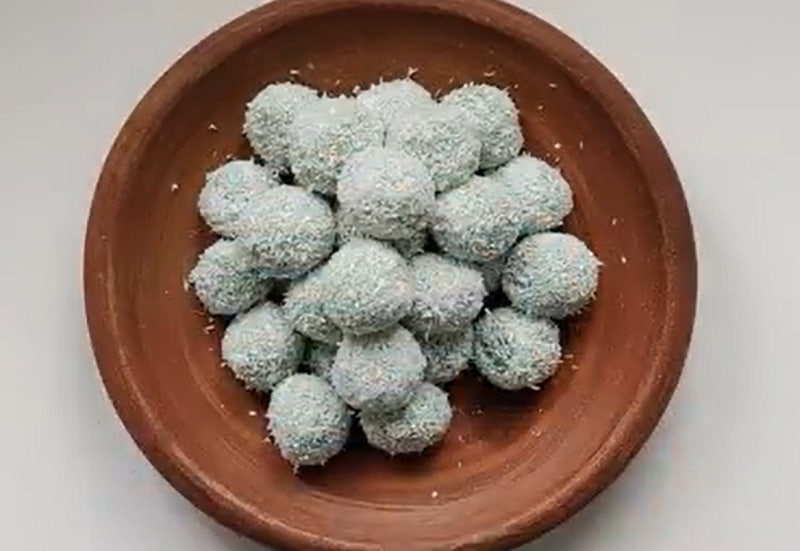
Klepon is a delectable rice cake that is boiled and filled with luscious liquid palm sugar, then delicately coated with shredded coconut. The dough is skillfully made using a mixture of glutinous rice flour and sometimes tapioca, along with a special paste made from pandan leaves. Tiny pieces of solid palm sugar are carefully inserted into the dough, resulting in perfectly shaped balls that are then boiled. As the balls are heated, the palm sugar melts, creating a delightful sweet liquid filling. Great care is taken to ensure that the liquid remains securely inside the balls. Finally, the balls are gently rolled in shredded coconut, which beautifully sticks to the sticky surface of the glutinous rice dough.
Emping
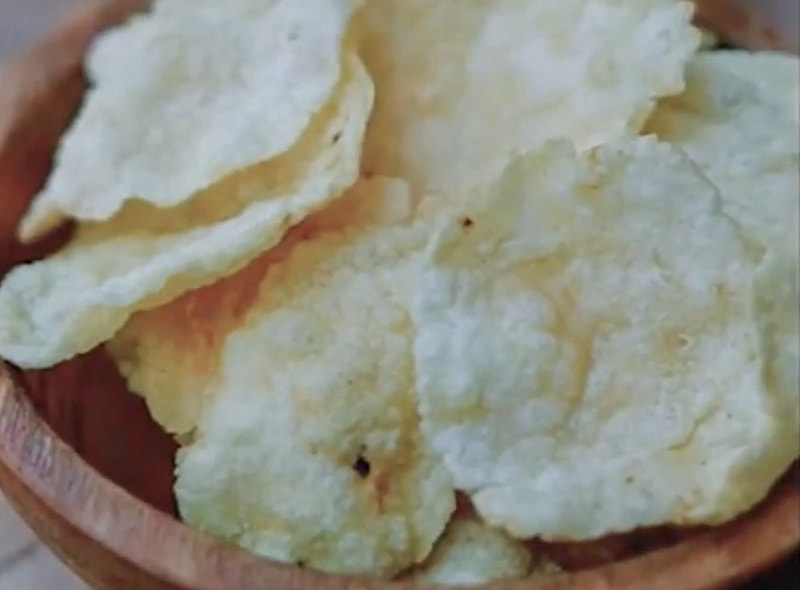
Emping is a traditional Indonesian vegetarian dish that is popularly enjoyed as a snack or side dish. It is made from melinjo nuts, which are indigenous to Indonesia and have a unique taste and texture. To prepare emping, the melinjo nuts are first boiled and then pounded to remove the skin. The nuts are then thinly sliced and deep-fried until they become crispy and golden brown. The result is a crunchy and savory snack that is packed with flavor. Emping is often served with various dipping sauces, such as chili sauce or peanut sauce, to enhance its taste. It can also be used as a topping for salads or vegetable dishes to add a crunchy texture. What makes emping special is its nutty and slightly bitter taste, which pairs well with the spicy and tangy flavors of Indonesian cuisine.
Pisang Goreng
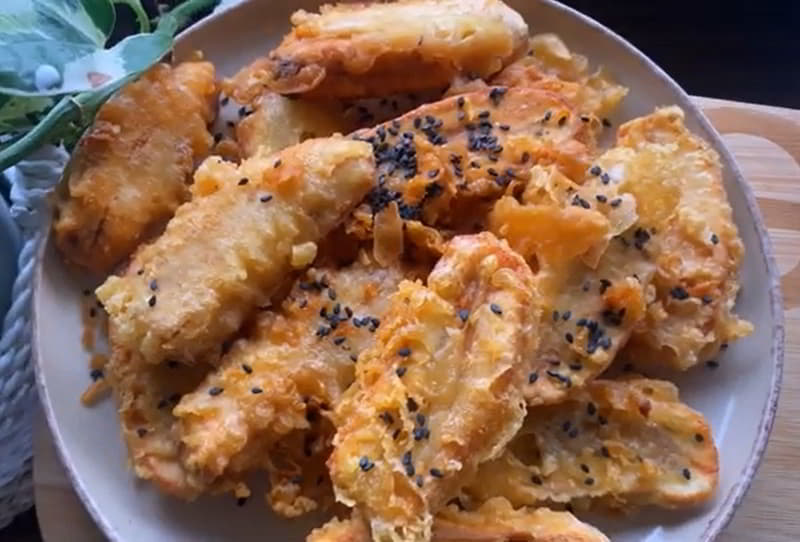
Pisang goreng is a delicious treat made by coating ripe bananas in a sweet, crispy batter and deep frying them until golden brown. It is commonly enjoyed as a snack or dessert. To prepare pisang goreng, ripe bananas are peeled and sliced lengthwise or into smaller pieces. The batter is made by combining flour, water, sugar, and a pinch of salt. Some variations of the batter may include additional ingredients like coconut milk or rice flour for added flavor and texture. The banana slices are then dipped into the batter, ensuring they are evenly coated, before being carefully placed into hot oil for frying. The fritters are fried until they turn golden and crispy on the outside, while still remaining soft and moist on the inside.
Ketupat

Ketupat, a popular dish in Indonesia, is a traditional Indonesian rice cake made from glutinous rice wrapped in coconut leaves and then boiled. It is commonly enjoyed during festive occasions like Hari Raya Aidilfitri and Hari Raya Aidiladha. The process of making ketupat involves soaking the glutinous rice in water, draining it, and then tightly packing it into diamond-shaped pouches made from coconut leaves. These pouches are then boiled for several hours until the rice is fully cooked. The coconut leaves not only give ketupat its unique shape but also impart a subtle aroma to the rice. Ketupat is typically served alongside various meat dishes like rendang, satay, or curry. The rice has a soft and sticky texture that complements the bold flavors of the accompanying dishes. Additionally, the coconut leaves add a touch of sweetness to the rice, enhancing its overall taste.
Acar
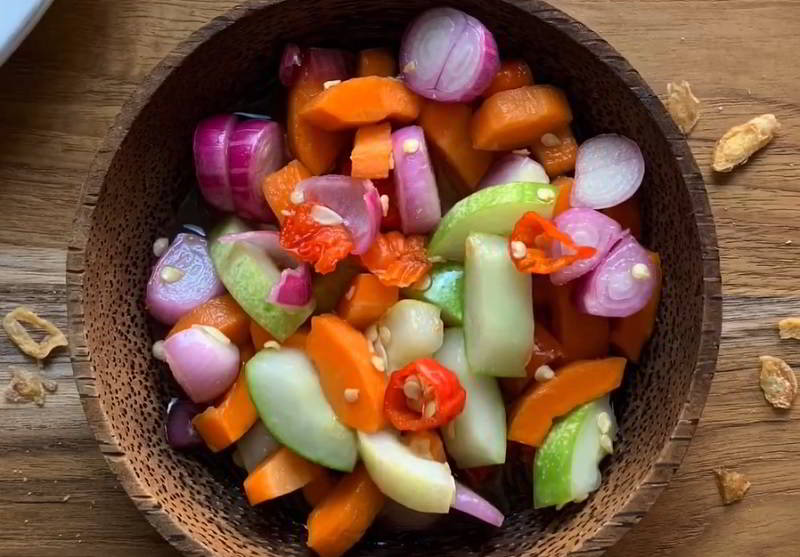
Acar is a traditional Indonesian vegetable pickle that is commonly made in large batches and stored in sealed jars for convenience. The ingredients used in acar include cucumber, carrots, cabbage, shallots, bird's eye chili, and yardlong beans. These vegetables are pickled in vinegar with kaffir lime and dried chilies, which gives the pickle a citrusy aroma. Some variations of acar also include ground peanuts, adding a unique twist to the flavor. Typically used as a condiment, acar's sourness adds a refreshing element to meals, especially when paired with fishy or rich, oily dishes like grilled fish or mutton satay, as it helps to balance out the richness.
Pecel
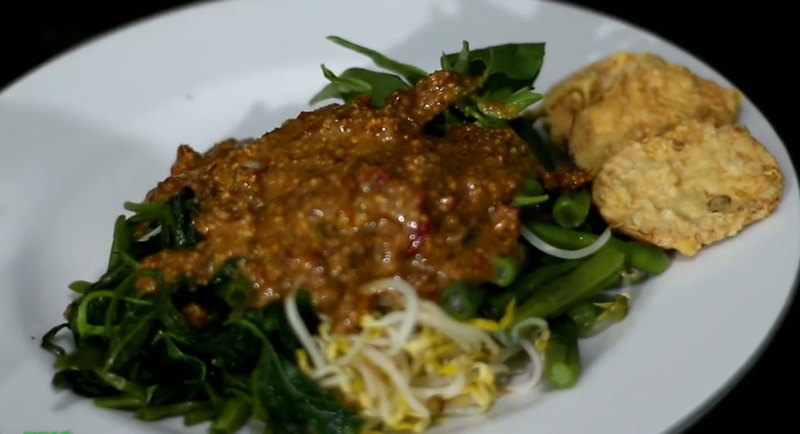
Pecel is a classic Javanese salad that combines leafy vegetables, bean sprouts, long beans, and cabbage with a delightful peanut sauce. Depending on the season, additional local vegetables like amaranth leaves or cassava leaves may be added. The sauce is made from roasted or fried peanuts, asam jawa, coconut sugar, and spices, and its thickness, sweetness, and spiciness can vary based on regional tastes. Pecel is commonly enjoyed with rice or rice cake (lontong or kupat), but it can also be enjoyed on its own or served alongside fried dishes.
Ketoprak
-1704285497.jpg)
Ketoprak, a beloved vegetable dish in Indonesia, is well-known for its delightful blend of flavors and textures. This traditional Javanese delicacy features a medley of fresh vegetables, tofu, rice vermicelli noodles, and a delectable peanut sauce. The vegetable selection in Ketoprak can vary, but commonly includes bean sprouts, cabbage, carrots, and cucumber, offering a satisfying crunch and natural sweetness to the dish. The tofu is fried to golden perfection, adding a crispy element that enhances the overall texture. However, the true star of Ketoprak is undeniably the peanut sauce. Crafted from ground peanuts, garlic, shallots, tamarind paste, and palm sugar, this creamy, nutty, and slightly tangy sauce is generously poured over the vegetables and noodles, resulting in a distinct and luxurious flavor.
Karedok
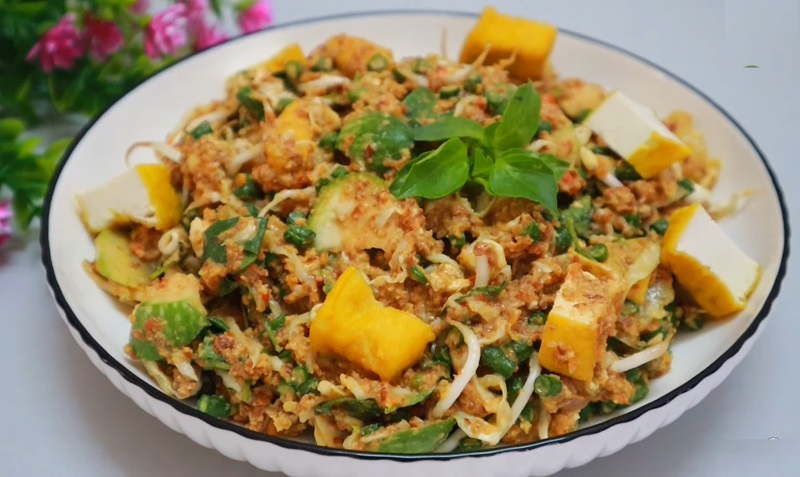
Karedok, a traditional vegetable dish from Indonesia, hails from the Sundanese cuisine of West Java. This delightful salad is known for its refreshing qualities and nutritious elements, making it an ideal choice for those seeking a light and healthy meal. The key components of Karedok typically include long beans, bean sprouts, cucumber, and cabbage, all thinly sliced or julienned. These vegetables are combined with a delectable peanut sauce, which is made by grinding roasted peanuts, garlic, chili, palm sugar, and tamarind juice. The result is a flavorful and mildly spicy dressing. To enhance the dish, Karedok is often adorned with fried shallots and served alongside traditional shrimp crackers. It can be relished on its own or served as a side dish to complement a main course.
Serabi

Serabi is a type of pancake that is commonly found throughout Indonesia. The main ingredient of serabi is rice flour, which gives it a unique texture and flavor. Other key ingredients include coconut milk, sugar, and pandan leaves, which add a fragrant aroma to the dish. To prepare serabi, the rice flour is mixed with coconut milk and sugar to form a smooth batter. This batter is then poured onto a hot griddle or pan and cooked until the edges are crispy and golden brown. The pandan leaves are often used as a natural food coloring, giving the serabi a vibrant green color. Serabi can be enjoyed on its own or with a variety of toppings. Some popular choices include sweet palm sugar syrup, grated coconut, or a sprinkle of sesame seeds. The dish is typically served warm, making it a comforting and satisfying treat.
Sayur Lodeh
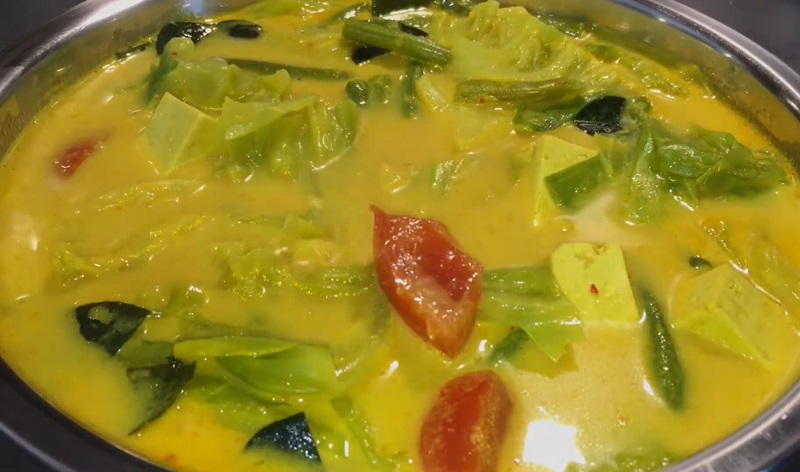
Sayur lodeh is a flavorful and aromatic vegetable stew cooked in coconut milk. The dish is packed with a variety of vegetables, making it not only nutritious but also visually appealing. The main ingredients of sayur lodeh include a combination of vegetables such as long beans, cabbage, carrots, tofu, and tempeh, which are all cooked in a rich and creamy coconut milk broth. The dish is seasoned with a blend of spices such as garlic, shallots, turmeric, and galangal, giving it a distinct Indonesian flavor. The vegetables in sayur lodeh are usually cooked until they are tender but still retain their vibrant colors and flavors. The addition of tofu and tempeh provides a good source of plant-based protein, making this dish satisfying and filling. Sayur lodeh is often served with steamed rice or as a side dish to accompany other Indonesian dishes.
Lalab
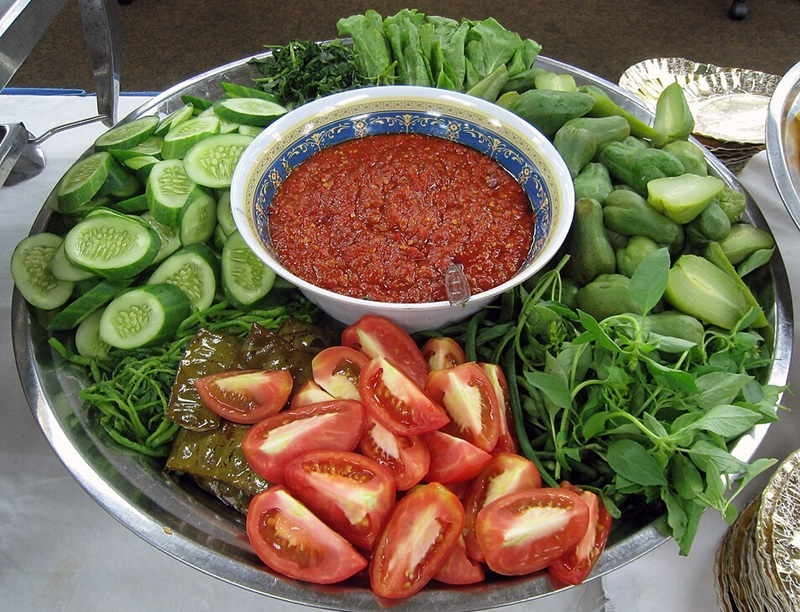
Lalab, a traditional Indonesian dish, is a delightful combination of fresh vegetables accompanied by a zesty dipping sauce. Originating from the West Java region of Indonesia, specifically in Sundanese cuisine, lalab showcases a variety of vegetables like cucumber, cabbage, long beans, spinach, and lettuce. These vegetables are typically served raw or lightly blanched to preserve their crispness and natural taste. The star of the dish is the sambal dipping sauce, crafted from chili peppers, shallots, garlic, lime juice, and shrimp paste, which adds a spicy and tangy twist. Lalab is often enjoyed as a refreshing side dish that perfectly complements main courses such as grilled fish or meat.
Tahu Goreng
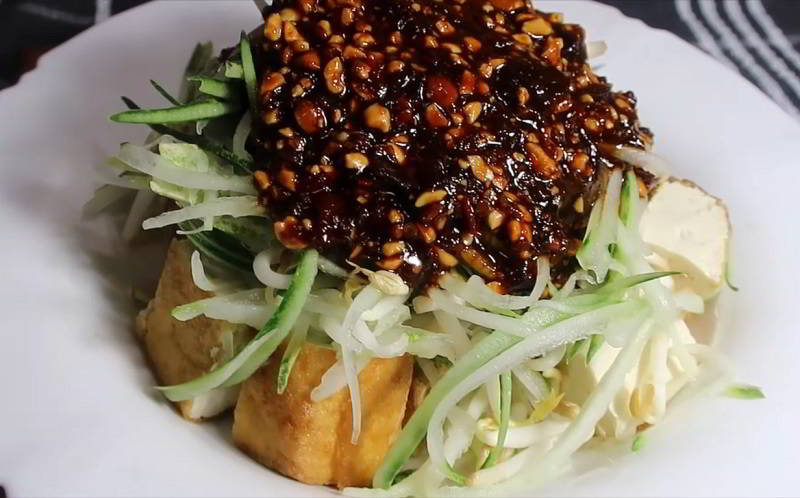
Tahu goreng is a popular vegetarian dish in Indonesia that features deep-fried tofu. It is a simple yet flavorful dish that is commonly enjoyed as a side dish or a snack. To prepare tahu goreng, firm tofu is usually cut into small rectangular pieces and then marinated in a mixture of soy sauce, garlic, and spices such as coriander and turmeric. The marinated tofu is then deep-fried until it becomes golden brown and crispy on the outside, while still remaining soft and moist on the inside. Tahu goreng is often served with a side of sweet and spicy peanut sauce, which adds a rich and nutty flavor to the dish. It is commonly garnished with fresh cucumber slices and fried shallots for an extra crunch and a burst of freshness.
Kripik

Kripik, a popular dish in Indonesia, is a delicious and crispy snack. This traditional dish is made from thinly sliced vegetables or fruits, which are then deep-fried until they become crispy and golden brown. One famous variation is kripik pisang, which is made by thinly slicing bananas and deep-frying them to a perfect crispy, golden brown. A delightful combination of sugar and salt is often sprinkled on top, creating a harmonious blend of sweet and savory flavors. Another popular variant is kripik tempe, made from fermented soybean cake. Thinly sliced tempe is deep-fried to achieve a crispy texture and enhanced with a flavorful mix of spices. Other kripik varieties include kripik singkong (cassava), kripik kentang (potatoes), and kripik ikan (fish).
Nagasari
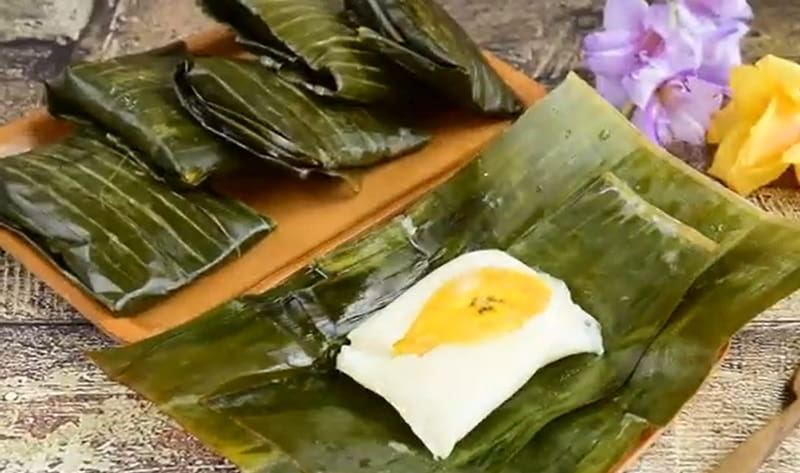
Nagasari, a traditional Indonesian dessert, is primarily made from two main ingredients: rice flour and coconut milk. The dish is steamed, giving it a soft and delicate texture. To make nagasari, rice flour is mixed with coconut milk to create a smooth batter. The batter is then poured into banana leaf cups and steamed until cooked. The result is a sweet and fragrant cake-like dessert. Nagasari is often enjoyed as a snack or dessert in Indonesia. It is known for its subtly sweet taste, infused with the aroma of coconut. The combination of the soft texture and the natural sweetness makes nagasari a delightful treat. Although traditionally made with rice flour and coconut milk, Nagasari can also be customized with other ingredients. Some variations include adding pandan leaves for a vibrant green color or adding slices of ripe banana for added sweetness.
Ulam
-1709875771.jpg)
Ulam is a delightful and nourishing dish that is commonly enjoyed as an appetizer or side dish. It is prepared using an assortment of fresh and vibrant vegetables, as well as aromatic herbs and spices. Typically, Ulam includes a combination of raw or blanched vegetables such as cucumber, bean sprouts, carrots, and cabbage, which are thinly sliced or shredded to provide a satisfying crunch. To elevate the flavor, fragrant herbs like basil, mint, and cilantro are often added as garnish. Additionally, a dressing is usually made with ingredients like lime juice, soy sauce, and chili peppers, which gives the dish a tangy and spicy kick.
Stir-Fried Water Spinach
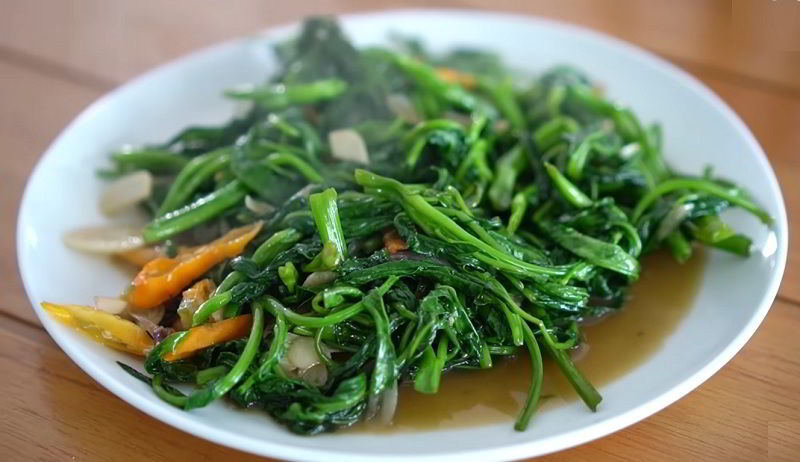
Stir-fried water spinach, known as "kangkung" in Indonesian, is a popular vegetarian dish in Indonesia. Kangkung is a leafy green vegetable with long, hollow stems, and it is commonly found in Indonesian cuisine. This dish is not only delicious but also quick and easy to prepare. To make stir-fried water spinach, the kangkung is first washed thoroughly and then cut into bite-sized pieces. In a hot wok or frying pan, oil is heated, and garlic and chili are added to infuse the oil with flavor. The kangkung is then added to the pan and stir-fried until it wilts but still retains its vibrant green color. A mixture of soy sauce, oyster sauce, and a pinch of sugar is added to enhance the flavors of the dish. The stir-fried water spinach is typically served as a side dish alongside steamed rice or as part of a larger Indonesian meal. Its crunchy texture, combined with the savory and slightly spicy flavors, makes it a delightful addition to any vegetarian spread.
Lupis
-1708385300.jpg)
Lupis, a beloved Indonesian dessert, is crafted from glutinous rice. This delightful confection is meticulously cooked to achieve a soft and sticky texture. The pliant rice is then molded into charming square parcels, elegantly enveloped in banana leaves, lending lupis its unmistakable appearance. To elevate its taste, these rice parcels are commonly accompanied by a delightful topping of grated coconut and adorned with a luscious syrup derived from palm sugar. The interplay of the tender and chewy rice, the creamy coconut, and the decadent sweetness of the syrup harmoniously meld together, resulting in a delectable blend of flavors.
Asinan

Asinan is a popular vegetarian dish in Indonesia that is made from a variety of fresh fruits and vegetables. The dish is typically a combination of crunchy and tangy flavors, making it a refreshing and delicious choice for those seeking a healthy and satisfying meal. The main ingredients used in asinan include cucumber, carrot, bean sprouts, pineapple, and mango, all of which are thinly sliced or julienned. These vegetables and fruits are then mixed together and tossed in a sweet and sour dressing made from vinegar, sugar, salt, and chili. To enhance the flavor, asinan is often garnished with roasted peanuts and fried shallots, which add a crunchy texture and a nutty taste to the dish. Some variations of asinan may also include tofu or tempeh for added protein.
Sayur Asem
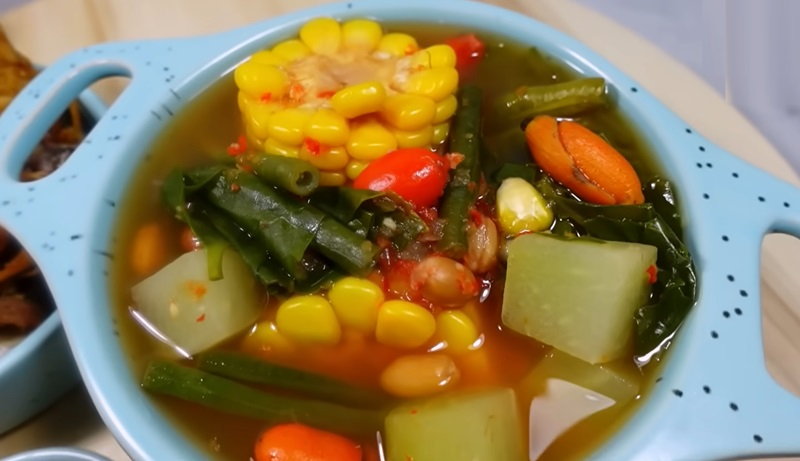
Sayur Asem is a well-known Indonesian soup that is loved for its invigorating and tangy taste. This traditional dish features a medley of vegetables cooked in a flavorful broth infused with tamarind. The name "sayur" means vegetable in Indonesian, while "asem" refers to the sourness. The soup typically includes a variety of vegetables such as green beans, corn, cabbage, long beans, and carrots. These vegetables are gently simmered in a broth made from tamarind pulp, which gives the dish its distinct sour flavor. To enhance the taste, ingredients like shallots, garlic, galangal, and bay leaves are added. Sayur Asem is commonly enjoyed with steamed rice and can be served as a main course or a side dish. The combination of tangy broth and fresh vegetables results in a delightful and comforting flavor profile.
Urap
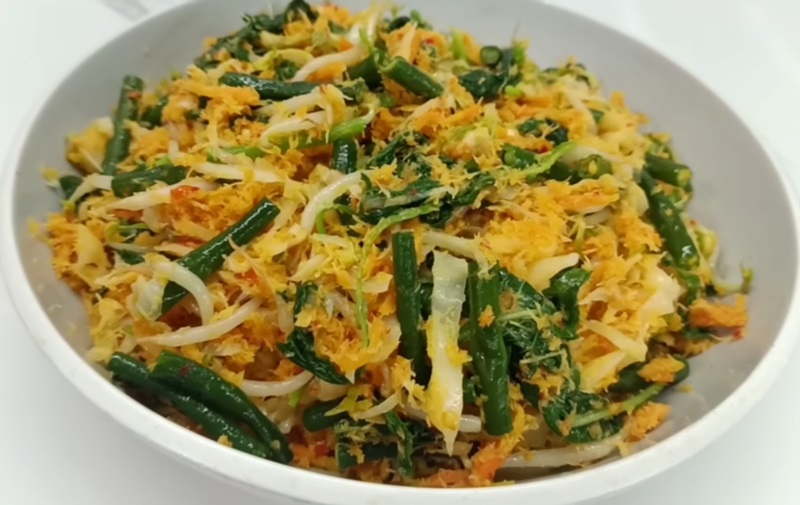
Urap, a traditional Indonesian dish, is a delightful vegetarian option that is bursting with vibrant flavors and textures. It is a colorful salad-like dish that is typically made with a combination of blanched vegetables, grated coconut, and a flavorful dressing. The star of the dish is the assortment of vegetables, which can include bean sprouts, green beans, spinach, cabbage, and carrots, among others. These vegetables are usually lightly blanched to retain their crispness and vibrant colors. Once the vegetables are cooked, they are combined with freshly grated coconut, which adds a creamy and slightly sweet touch to the dish. The grated coconut is often toasted to enhance its nutty flavor. To bring all the flavors together, Urap is typically dressed with a mixture of spices, such as shallots, garlic, chili, galangal, and turmeric, which are ground into a paste and then sautéed. This dressing is further enhanced with tamarind juice, lime juice, and a touch of palm sugar for a perfect balance of tanginess and sweetness.
Burasa
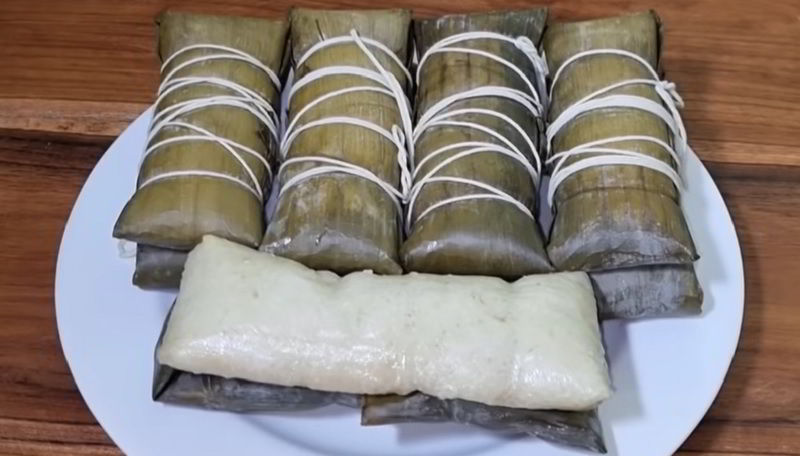
Burasa, a traditional Indonesian dish, is a delectable rice dumpling infused with coconut milk and wrapped in a banana leaf. To make burasa, rice is first partially cooked and then simmered in coconut milk with daun salam (Indonesian bay leaf) and salt until it absorbs the flavors. The half-cooked coconut milk rice is then shaped into cylindrical or pillow forms, wrapped in banana leaves, and secured with banana leaf fiber strings. These rice packages are steamed to perfection and are commonly served in pairs.
Tauge Goreng
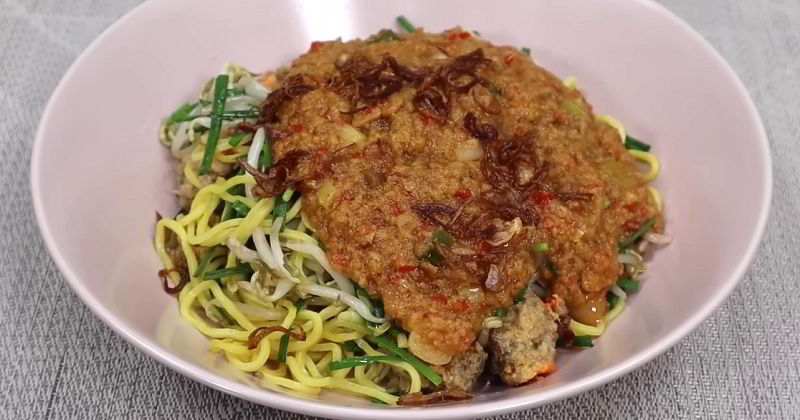
Tauge goreng is a popular vegetarian dish in Indonesia that features stir-fried bean sprouts as the main ingredient. This dish is not only delicious but also nutritious and easy to prepare. To make tauge goreng, fresh bean sprouts are first blanched in boiling water for a short period to maintain their crunchiness. Then, they are quickly stir-fried in a wok with various ingredients such as garlic, shallots, chili peppers, and soy sauce. Some variations may also include other vegetables like carrots and cabbage for added flavor and texture. The result is a simple yet flavorful dish with a combination of crunchy bean sprouts and aromatic spices.
Sayur Bayam

Sayur bayam is a well-loved Indonesian soup celebrated for its delightful tastes and straightforwardness. This classic dish showcases amaranth as the star ingredient, ensuring a nourishing and wholesome option. To make sayur bayam, the amaranth is simmered in a delectable broth infused with a medley of spices like garlic, shallots, ginger, and turmeric. These spices contribute a fragrant scent and a subtle kick of spiciness to the soup. Additionally, ingredients such as tomatoes, carrots, and corn are commonly included to elevate the flavor profile and texture of the soup.
Pisang Cokelat
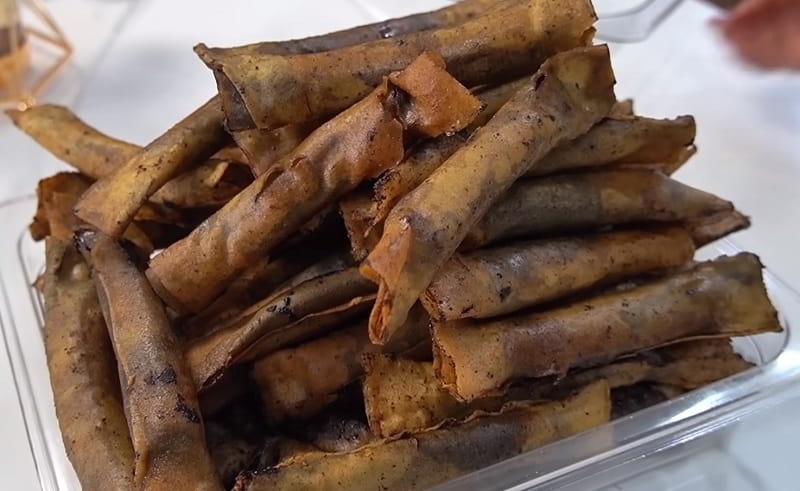
Pisang cokelat, also known as chocolate-covered bananas, is a beloved Indonesian snack that combines the sweetness of ripe bananas with the richness of chocolate. It is enjoyed by locals and tourists alike for its simplicity and deliciousness. To prepare pisang cokelat, ripe bananas are peeled and cut into bite-sized pieces, which are then skewered on wooden sticks. As a generous amount of chocolate is melted and kept warm, the banana skewers are dipped into the molten chocolate, ensuring complete coating. Some variations may include toppings like crushed peanuts, sprinkles, or shredded coconut for added texture and flavor. After the chocolate-covered banana skewers cool and harden, they create a delightful combination of creamy chocolate and soft, sweet banana.
Tahu Gejrot

Tahu gejrot is a popular vegetarian dish in Indonesia, originating from the city of Cirebon in West Java. It consists of fried tofu cubes that are served in a tangy and spicy sauce. The tofu is deep-fried until golden brown, giving it a crispy exterior while maintaining a soft and silky texture inside. The sauce is the highlight of this dish, made from a combination of soy sauce, vinegar, palm sugar, garlic, shallots, and chili peppers. The sauce is typically sweet, sour, and spicy, creating a delightful explosion of flavors on the palate. It is common to find additional toppings such as sliced cucumber, chopped tomatoes, and fried shallots to add freshness and texture. Tahu gejrot is usually served as a street food, where it is enjoyed as a snack or appetizer.
Wingko

Wingko is a traditional Indonesian dish that is popular among vegetarians. It originated from the Javanese culture and is commonly found in Central Java. Wingko is a sweet and savory cake made from grated coconut, rice flour, palm sugar, and a variety of other ingredients. To prepare wingko, the grated coconut is mixed with rice flour and palm sugar, giving it a sticky and chewy texture. This mixture is then baked until it turns golden brown and crispy on the outside. The aroma of the toasted coconut fills the air, making it even more enticing. The taste of wingko is a delightful combination of sweetness from the palm sugar and the richness of the coconut. It is often enjoyed as a snack or dessert, and can be served warm or at room temperature.
Plecing Kangkung
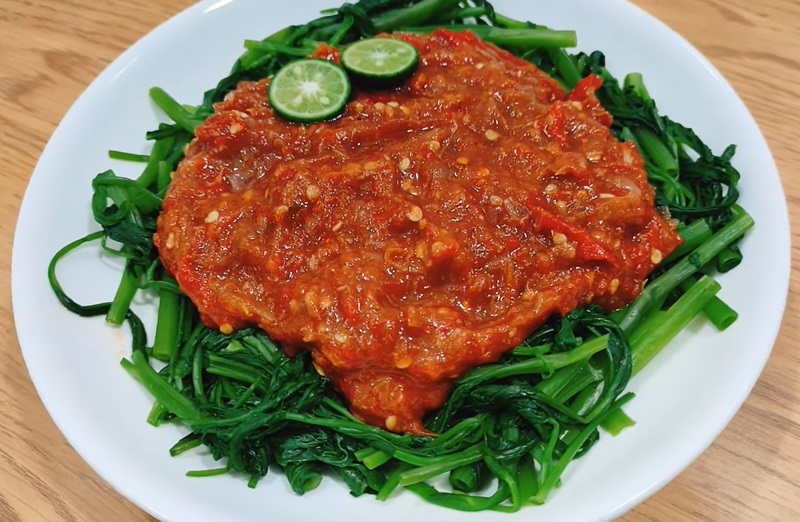
Plecing Kangkung is a well-liked vegetable dish originating from Indonesia. It features kangkung, also known as water spinach, which is blanched and served with a zesty sambal sauce. To prepare this dish, the kangkung leaves are briefly boiled until they reach a tender state while keeping their vibrant green color. Once blanched, the kangkung is drained and presented on a plate. The star of the show is the fiery sambal sauce that accompanies the kangkung. This sauce is typically made by grinding together red chili peppers, shallots, garlic, shrimp paste, and lime juice, resulting in a spicy, tangy, and flavorful condiment.
Tahu Sumedang

Tahu Sumedang is a well-loved fusion dish hailing from the Sumedang region in West Java, Indonesia. It was originally crafted by Ong Kino, a Chinese-Indonesian individual. This delectable dish combines tofu with a medley of ingredients and flavors, resulting in a distinct and appetizing creation. The star ingredient, tofu, is derived from soy milk and is renowned for its versatility. In Tahu Sumedang, the tofu is typically fried until it becomes crispy on the outside, while remaining tender and smooth on the inside. It is traditionally served alongside a complementary side dish. To enhance its taste, the dish is often accompanied by a spicy sweet soy sauce, sambal, and/or lontong.
Kue Cubit

Kue cubit, also known as "pinch cake" in English, is a beloved Indonesian snack that appeals to people of all ages. These small, delectable treats combine the lightness of pancakes with sweet toppings, making them an ideal choice for a quick snack or a delightful indulgence. The name "kue cubit" derives from the method of creation, where the batter is pinched with a special tool or by hand to form tiny, round shapes. The batter itself consists of a blend of flour, sugar, eggs, milk, and a hint of vanilla extract for an added touch of flavor. Once mixed, the batter is poured onto a hot griddle and cooked until it turns a golden brown hue. What sets kue cubit apart is the wide range of toppings that can be added. Whether it's chocolate sprinkles, rainbow sprinkles, grated cheese, or condensed milk, the possibilities are endless. Each bite-sized cake is then adorned with the desired toppings, providing an explosion of flavors and textures.
Cenil

Cenil, a well-loved Indonesian snack, is adored by people of all ages. This sweet and chewy delicacy is crafted from a blend of tapioca flour and grated coconut. The dough is created by combining tapioca flour with water and then shaping it into small balls. These delectable balls are boiled to perfection until they reach a soft and chewy consistency. Once cooked, the cenil balls are drained and generously coated with grated coconut, offering a delightful blend of sweetness and nuttiness. Some variations of cenil incorporate palm sugar or pandan leaves, adding a touch of sweetness and fragrance. Not only is cenil a tasty treat, but it also boasts an appealing appearance. The small, colorful balls create an attractive presentation, making it a popular choice for special occasions or as a post-meal dessert. Whether enjoyed on its own or used as a topping for other desserts, cenil promises to satisfy your sweet cravings. Its soft and chewy texture, along with the subtle flavors of coconut and palm sugar, make it an irresistible Indonesian snack.
Sayur Sop
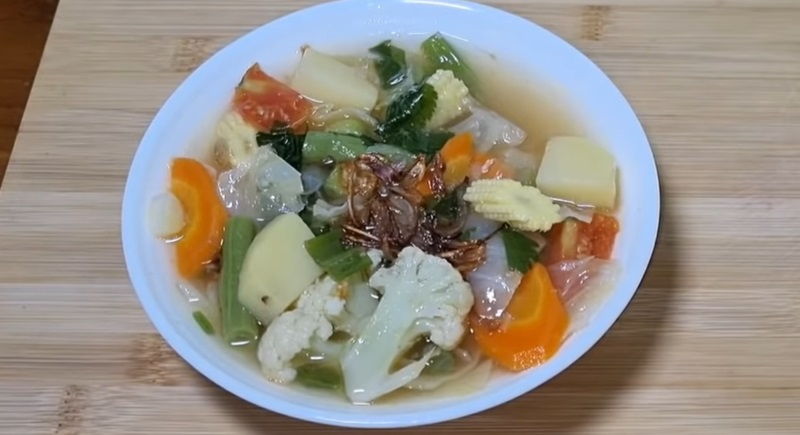
Sayur Sop is a traditional Indonesian soup that offers both health benefits and a delightful taste. The term "sayur" signifies vegetables, while "sop" refers to a soup. This dish brings together an exquisite combination of fresh vegetables, meat, and a flavorful broth. The base of sayur sop typically consists of chicken or beef broth, infused with aromatic spices like garlic, shallots, and ginger. The soup is enriched with an array of vegetables such as carrots, cabbage, green beans, and potatoes, making it a satisfying and nutritious meal. For those seeking a protein element, sayur sop often incorporates chicken or beef chunks, as well as shrimp. The meat is usually boiled to achieve tenderness before being added to the soup. Additionally, some variations of sayur sop include tofu or tempeh, offering a vegetarian alternative.
Colo-Colo (condiment)
-1709888825.jpg)
Colo-colo, a popular condiment in Indonesia, is a vegetarian dish that adds a burst of flavor to any meal. It is commonly served with grilled or steamed vegetables, rice, and tofu. This traditional dish originates from the North Sulawesi province and is known for its spicy and tangy taste. The main ingredients of colo-colo include fresh tomatoes, chili peppers, shallots, lime juice, and salt. These ingredients are finely chopped and mixed together to create a vibrant and aromatic sauce. Additional ingredients such as lemongrass, galangal, and shrimp paste may also be added to enhance the flavor. Colo-colo is versatile and can be adjusted to suit individual preferences. Some variations may include the addition of diced mango or pineapple to give it a sweet and sour twist. This condiment adds a refreshing and zesty element to any dish, making it a beloved staple in Indonesian cuisine.
Gethuk

Gethuk, a popular Indonesian snack, is made from cassava or sweet potatoes and is loved for its chewy texture and sweet taste. It is especially enjoyed in the Central Java and Yogyakarta regions of Indonesia. To create Gethuk, the cassava or sweet potatoes are cooked and mashed into a smooth paste, which is then sweetened with palm sugar. Sometimes, grated coconut is added for extra richness. The mixture is then shaped into small bite-sized pieces, often resembling balls or cylinders. Gethuk can be savored on its own or paired with a cup of hot tea or coffee.
Kuluban
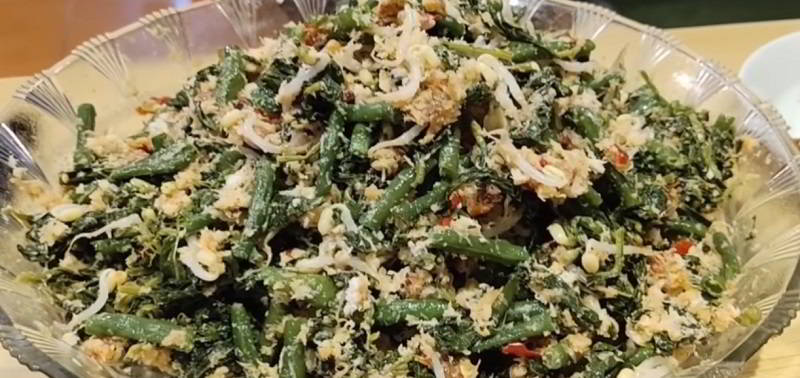
Kuluban originates from Central Java and is a customary salad dish enjoyed either independently as a vegetarian meal or as a complement to other dishes. Its ingredients typically include string beans, petai (stink beans), young jackfruit, orange leaves, bean sprouts, kencur (aromatic ginger), terasi (shrimp paste), shredded young coconut, red peppers, salt, and sugar. Many recipes also suggest adding kerupuk (crackers) for a crunchy texture. This salad combines various vegetables and spices, creating a harmonious blend of flavors and textures.
Timphan
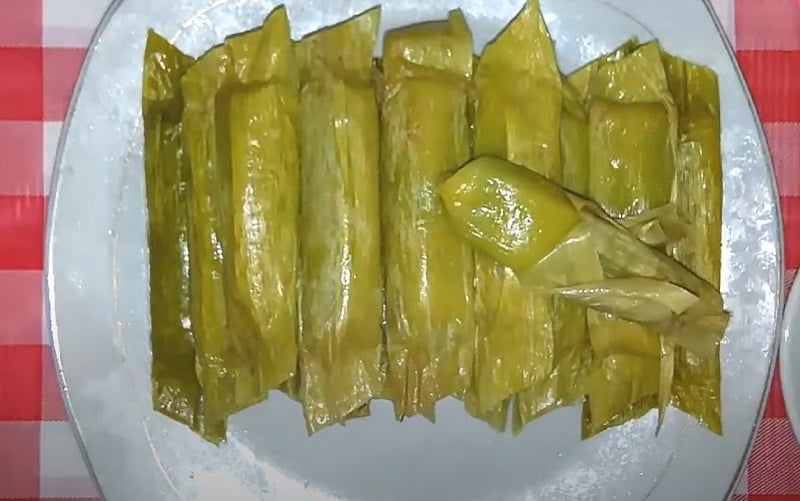
Timphan is a steamed banana dumpling originating from Aceh, Indonesia. This traditional sweet snack, called kue, is commonly enjoyed on special occasions, particularly during Eid and other festive events. To create timphan, skilled artisans combine glutinous rice flour, mashed banana, and coconut milk to achieve a thick and dough-like consistency. The banana-infused rice flour dough is then spread lengthwise to form the base for the delectable filling. Typically, the filling consists of sweetened serikaya or grated coconut mixed with sugar, adding layers of sweetness and flavor to the dumpling.
Tempeh Burger

The Tempeh burger is a popular vegetarian dish in Indonesia that offers a delicious and nutritious alternative to traditional meat burgers. Tempeh, a staple in Indonesian cuisine, is made from fermented soybeans and is known for its high protein content and nutty flavor. To create a Tempeh burger, the tempeh is typically marinated in a mixture of soy sauce, garlic, ginger, and other spices to enhance its taste. It is then pan-fried or grilled until it becomes crispy on the outside and tender on the inside. The cooked tempeh patty is placed on a toasted burger bun and garnished with various toppings such as lettuce, tomato, onion, and cheese. This vegetarian dish not only satisfies the craving for a hearty burger but also provides a good source of protein and essential nutrients.
Docang
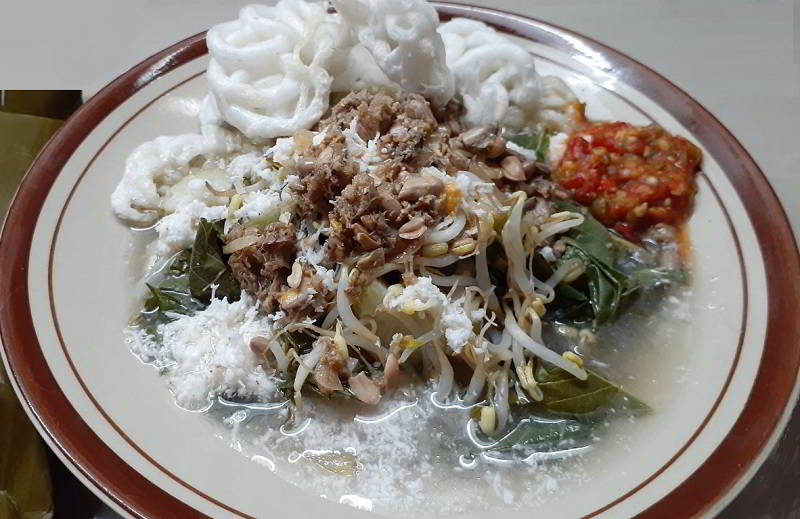
Docang is a traditional dish of Cirebon, a coastal town in West Java, Indonesia. It consists of sliced rice cake, cassava leaves, sprouts, and krupuk (crackers), served in a thick vegetable sauce known as dage. The dage is prepared by mashing tempeh and mixing it with grated coconut, creating a rich and savory flavor. Typically served warm, docang is a popular choice for breakfast due to its hearty and fulfilling nature.





